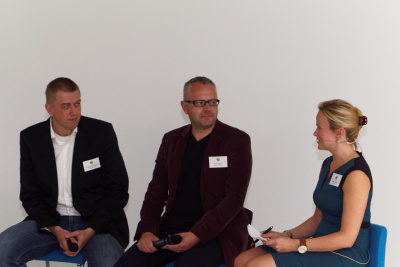The next panel consisted of regular contributors to our news, Stephan Heimbecher of Sky Deutschland and Roland Vaiclu of Dolby Labs.
Heimbecher started saying that Sky has run two plugfests at the centre over the last year, as even just one year ago there were some issues in interoperability between UltraHD devices and sets. The first was in December and the second more recently. Heimbecher described it as UltraHD “Speed dating” with 30 minute sessions between source devices and displays. There have been a lot of changes in connectivity over the last couple of years. The next plugfest is expected to be in December and there will be a lot of focus on HDR at the plugfest. It is not a certification programme, it’s just a chance to get a lot of experience quickly.
Heimbecher said that Sky is trying to develop a real next step in customer experience, which is not just UltraHD resolution, but also includes HDR, HFR and other features. Unfortunately, there is no agreement in the industry on the roadmap, and that means that progress is slow. For Sky, the critical content is the live content and it’s really important to understand the live production processes and optimise them. Sky looked at the Dolby PQ curve and also a modified log curve in the tests, but Heimbecher didn’t quote the result. (He said a lot more about this at the IHS event at IFA, check Panel Reviews UltraHD Future.)

The High Five topics from two years ago were HDCP, HEVC, HFR, HDR and HDMI. Some progress has been made, but not really enough, and not quickly enough in Sky’s view.
Vaiclu said that the acronyms are not the way to market these things and he said you need to concentrate on the benefits and communicate them to consumers. Dolby is trying to put the Dolby Vision name to the dual features of HDR and WCG, doing one alone doesn’t really work as well as you would like. TVs have a wide range of colour volumes and mapping content to these volumes is critical to deliver a good image. Simply looking at gamut, white point and gamma doesn’t really give a good result across multiple TVs.
In terms of optimum use of bandwidth, HDR has advantages, but UltraHD is going to come, anyway. In response to a question, Vaiclu said that Dolby starts at the camera to try to cover the whole path from the lens of the camera to the set in the living room, which is very appealing to content creators. Dolby has been working on the content creators for three years.
Mediatek, Realtek, Hivision all announced support for Dolby Vision in their TV chipsets at the start of IFA (See Matt’s HDR Coming “Real Soon Now” for more on this.)
Vaiclu said that Dolby is working on developing real time techniques for sports to allow simultaneous HDR & SDR from a single HDR camera and Dolby is working with Grass Valley and others. This will be critical for HDR as, unlike 3D, it will allow single capture.

